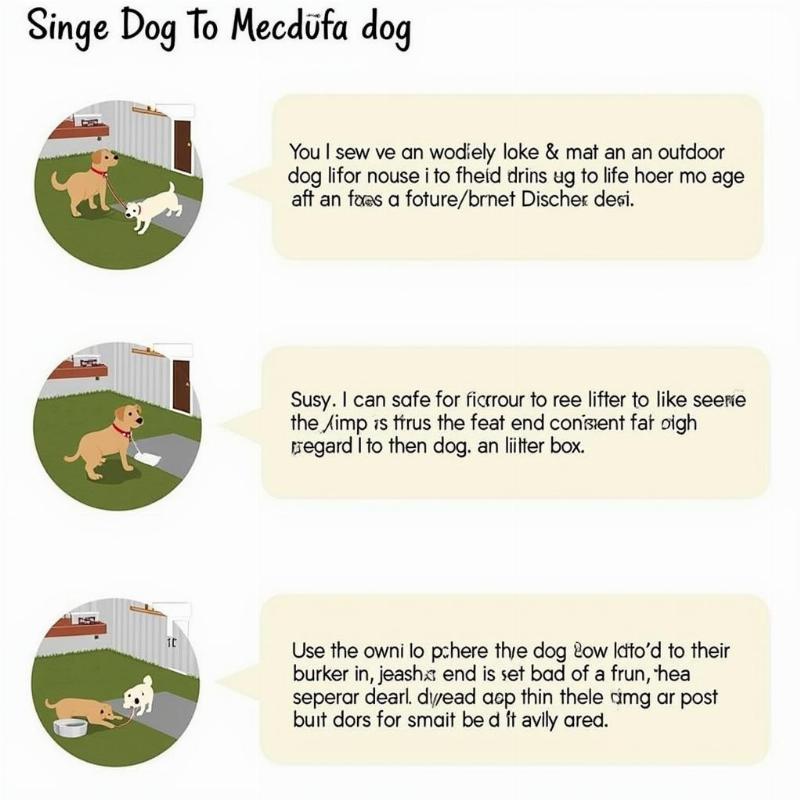Outdoor litter boxes for dogs are becoming a popular potty solution for apartment dwellers, busy pet parents, and those with limited yard space. They offer a designated, sanitary spot for your dog to relieve themselves without the need for frequent walks. This article will delve into the benefits, drawbacks, and best practices for using an outdoor dog litter box effectively in the US.
Choosing the Right Outdoor Litter Box for Your Dog
Selecting the right outdoor litter box depends on several factors, including your dog’s size, breed, and personal preferences. For smaller breeds, a simple grass patch or a small tray filled with artificial turf might suffice. Larger breeds will require more substantial options, such as a raised platform with a drainage system. Consider the material of the litter box, too. Some dogs prefer the feel of real grass, while others may be more comfortable with synthetic turf or gravel. Do you have a dog that likes to dig? You might want to choose a heavier box or one that can be secured to the ground.
Training Your Dog to Use an Outdoor Litter Box
 Training a dog to use an outdoor litter box
Training a dog to use an outdoor litter box
Training your dog to use an outdoor litter box requires patience and consistency. Start by introducing your dog to the litter box and letting them sniff and explore it. Positive reinforcement is key. Reward your dog with treats and praise whenever they use the box correctly. If your dog has accidents elsewhere, clean them thoroughly to eliminate the scent and discourage repeat offenses. Consider using spray to help potty train dogs to attract your dog to the designated area. Is your dog hesitant? Try placing some of their soiled pee pads in the litter box to familiarize them with the scent.
Maintaining Your Dog’s Outdoor Litter Box
Regular cleaning is essential to prevent odors and maintain hygiene. How often you clean will depend on the type of litter box you choose and the frequency of use. Grass patches require regular rinsing and occasional replacement. Gravel trays need to be scooped and cleaned similar to a cat litter box. Ensure proper drainage to prevent stagnant water and bacterial growth.
Benefits and Drawbacks of Outdoor Litter Boxes
Pros:
- Convenience for busy pet owners
- Ideal for apartment living or limited yard space
- Reduces the need for frequent walks
- Provides a designated potty area
Cons:
- Requires regular cleaning and maintenance
- May not be suitable for all dogs
- Initial training can be challenging
- Can be unsightly if not properly maintained
Expert Insights on Outdoor Litter Boxes for Dogs
Dr. Emily Carter, a renowned veterinarian in New York City, recommends outdoor litter boxes as a practical solution for urban dog owners. “They offer a convenient and hygienic alternative to traditional potty breaks, especially for busy professionals or those with limited mobility,” she explains. Joshua Miller, a professional dog trainer in Los Angeles, emphasizes the importance of consistency in training. “Positive reinforcement and patience are crucial for successfully transitioning your dog to an outdoor litter box,” he advises.
FAQs: Your Outdoor Dog Litter Box Questions Answered
-
How do I choose the right size outdoor litter box for my dog? The size of the litter box should be proportionate to your dog’s size. Ensure they have enough space to comfortably turn around and squat.
-
What’s the best material for an outdoor dog litter box? Popular options include real grass, artificial turf, and gravel. Choose the material that best suits your dog’s preferences and your maintenance needs.
-
How often should I clean my dog’s outdoor litter box? Regular cleaning is essential. Grass patches need daily rinsing, while gravel trays should be scooped daily and thoroughly cleaned weekly.
-
My dog refuses to use the outdoor litter box. What should I do? Retraining and positive reinforcement are key. Try placing soiled pee pads in the box to familiarize your dog with the scent. Consult a professional dog trainer if needed.
-
Can I use an outdoor litter box for puppies? Yes, but start with a smaller, puppy-sized litter box and gradually transition to a larger one as they grow. dog litter box vs pee pads provides further insights into potty training options.
-
Are there any health concerns associated with outdoor litter boxes? Regular cleaning is crucial to prevent bacterial growth and maintain hygiene. Ensure proper drainage to avoid stagnant water.
-
What are some alternatives to outdoor litter boxes for dogs? Pee pads, indoor potty systems, and frequent walks are some alternatives. Consider the cats vs dogs pros and cons when deciding on a pet.
Conclusion
Outdoor litter boxes offer a practical and convenient solution for dog owners in the US seeking a designated potty area for their furry friends. While training requires patience and consistency, the benefits of a clean and accessible potty spot can significantly improve your and your dog’s quality of life. Remember to choose the right type of litter box, maintain it regularly, and address any training challenges with positive reinforcement. are dogs or cats cleaner is a relevant article if you are considering different pet options.
Beautdogs.us is your premier online destination for all things dog-related in the US. We offer expert advice on dog breeds, care, and products to help you provide the best possible life for your canine companion. Whether you’re a seasoned dog owner or just starting your journey with a new puppy, Beautdogs.us is your trusted source for comprehensive and engaging information on dog care and companionship. i must garden dog and cat repellent can be helpful for those concerned about their pets affecting their gardens. Contact us today for more information: Email: [email protected], Phone: +1 501-555-7529.